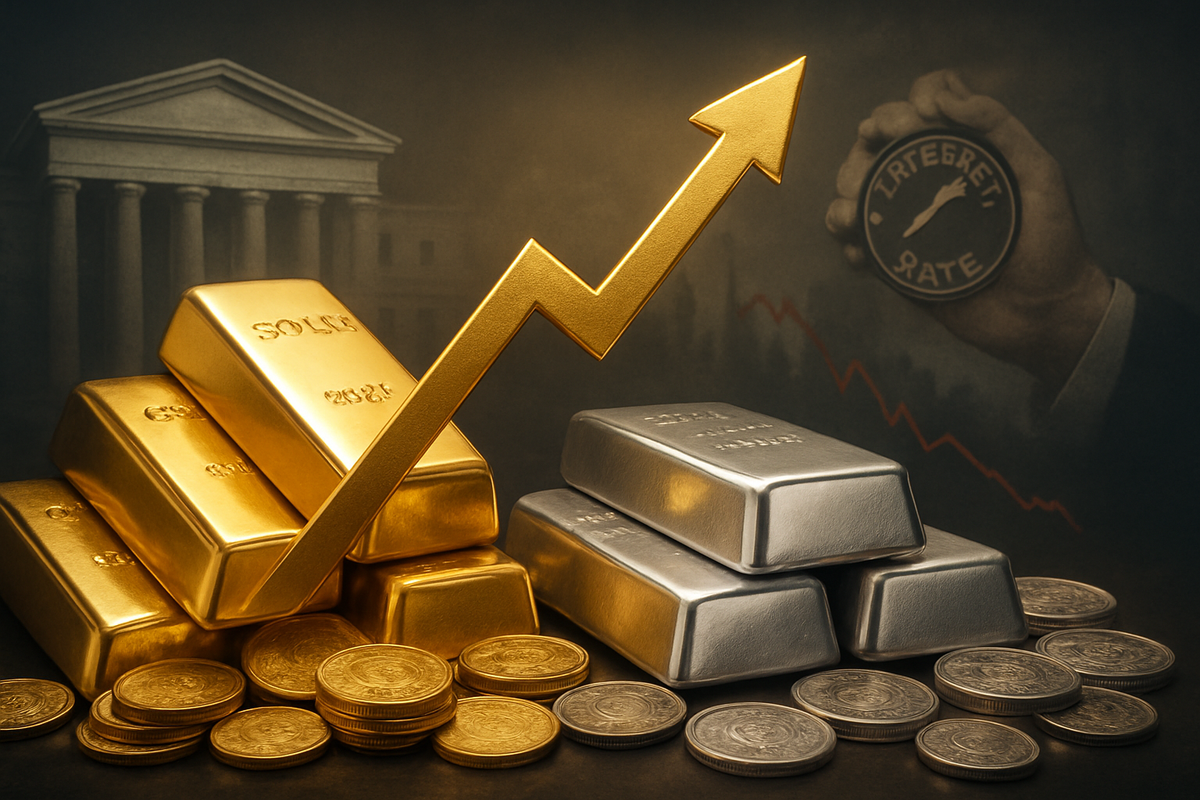
The global financial markets are currently witnessing a fascinating dichotomy: a significant surge in gold and silver prices, even as the U.S. Federal Reserve maintains a hawkish stance on interest rates despite clear signals of a softening labor market. This complex interplay of factors has propelled precious metals to unprecedented levels in 2025, with gold comfortably above $4,000 per troy ounce and silver reaching an all-time high of $54.42 per troy ounce in mid-November. Investors are grappling with the Fed's commitment to battling persistent inflation, even if it means tolerating higher unemployment, creating a volatile yet potentially lucrative environment for safe-haven assets.
This surge underscores a growing investor anxiety about economic stability and currency devaluation, positioning gold and silver as critical hedges against uncertainty. While the Fed's earlier rate cuts contributed to the rally, the current "higher-for-longer" interest rate narrative, coupled with a strengthening U.S. dollar, is introducing short-term pressures. However, the underlying economic fragility, evidenced by rising joblessness, continues to fuel the long-term appeal of these precious metals.
The Fed's Tightrope Walk: Inflation vs. Unemployment
The year 2025 has been marked by a series of pivotal events shaping the precious metals market. The Federal Reserve, under significant pressure to tame stubborn inflation, implemented two quarter-point interest rate cuts in September and October, bringing the federal funds rate to a target range of 3.75%–4.00%. These initial cuts were a significant catalyst for the rally in gold and silver, as lower interest rates reduce the opportunity cost of holding non-yielding assets.
However, the celebratory mood among precious metal bulls has been tempered by the Fed's subsequent rhetoric. Despite the U.S. unemployment rate rising to 4.4% in September—its highest since October 2021—and continuing jobless claims reaching their highest level since November 2021, many Fed officials have expressed persistent concerns about inflation, which remains stubbornly at 3%. This has led to a noticeable cooling in market expectations for a further rate cut in December, with probabilities dropping from a high of 95% to between 30-50% by mid-November 2025. This "higher-for-longer" interest rate narrative has introduced short-term headwinds for gold and silver, causing a slight dip in prices.
The timeline leading up to this moment is crucial: earlier in 2025, expectations of monetary easing and a weaker U.S. dollar fueled the initial precious metals ascent. Gold (XAU) reached an all-time high of $4,381.58 in October, while silver (XAG) saw an even more dramatic rise, hitting its unprecedented peak of $54.42 on November 14, 2025. Key players in this scenario include the Federal Reserve's Open Market Committee (FOMC), whose divided opinions on future monetary policy are closely scrutinized, and institutional investors, who are constantly rebalancing portfolios between inflation hedges and interest-bearing assets. The initial market reaction has been one of increased volatility, as traders try to reconcile the conflicting signals from a softening economy and a resolute central bank.
Companies Poised to Win or Lose in a Shifting Landscape
The surge in gold and silver prices presents a mixed bag for public companies, creating clear winners and potential losers depending on their exposure to the precious metals sector and their operational efficiencies.
Mining Companies: The Obvious Beneficiaries Major gold and silver mining companies are the most direct beneficiaries of rising prices. Companies like Barrick Gold Corp. (NYSE: GOLD), Newmont Corporation (NYSE: NEM), and Agnico Eagle Mines Ltd. (NYSE: AEM) for gold, and Pan American Silver Corp. (NASDAQ: PAAS) and First Majestic Silver Corp. (NYSE: AG) for silver, stand to see significant boosts to their revenues and profitability. Higher commodity prices directly translate to fatter profit margins, assuming their production costs remain stable. These companies often experience increased investor interest, leading to higher stock valuations. However, their success also hinges on their ability to manage operational costs, navigate regulatory landscapes, and maintain strong production levels. Investors will be closely watching their upcoming earnings reports for evidence of this windfall.
Precious Metal ETFs and Investment Vehicles: Exchange-Traded Funds (ETFs) that track gold and silver prices or hold physical metal, such as the SPDR Gold Shares (NYSE Arca: GLD) and the iShares Silver Trust (NYSE Arca: SLV), have seen substantial inflows and appreciation. These vehicles provide an accessible way for investors to gain exposure to the precious metals market without directly owning the physical commodity. Companies managing these funds, as well as brokerages facilitating their trading, could see increased transaction volumes and management fees.
Industrial Consumers of Silver: Potential Losers While industrial demand is a key driver for silver's price, particularly from renewable energy and semiconductor sectors, sustained high prices could become a double-edged sword for companies that heavily rely on silver as a raw material. Manufacturers of solar panels, electronics, and electric vehicles, for instance, might face increased input costs, potentially squeezing their profit margins or forcing them to pass on higher costs to consumers. Companies like First Solar, Inc. (NASDAQ: FSLR) or various semiconductor manufacturers, while benefiting from overall tech trends, might feel the pinch of expensive silver, potentially impacting their competitive pricing strategies.
Financial Institutions and Hedging: Banks and financial institutions involved in commodity trading and hedging activities will experience increased volatility but also opportunities. Those with well-managed hedging strategies for their clients or proprietary desks could capitalize on price movements, while those caught off guard by rapid shifts could face losses. The broader market implications for financial stability could also influence banks' lending and investment strategies.
Wider Significance: A Return to Fundamentals
The current surge in gold and silver, juxtaposed with the Fed's stance, fits into several broader industry trends and carries significant implications. Firstly, it underscores a global shift towards de-dollarization and diversification among central banks. Many central banks, particularly from emerging economies, have been consistently increasing their gold reserves, viewing it as a reliable store of value amidst geopolitical uncertainties and a hedge against the dominance of the U.S. dollar. This sustained institutional buying provides a strong underlying floor for gold prices.
Secondly, the event highlights the enduring role of precious metals as safe-haven assets during times of economic and geopolitical stress. The ongoing conflicts, global supply chain disruptions, and the specter of inflation have collectively pushed investors towards tangible assets. This trend is likely to continue as long as global stability remains elusive.
Historically, periods of rising unemployment combined with persistent inflation (stagflationary concerns) have often been bullish for gold. The current situation, with rising joblessness and inflation at 3% (above the Fed's 2% target), draws parallels to such environments. While the Fed is attempting to engineer a "soft landing," the market is increasingly pricing in the risk of a harder economic slowdown, which traditionally favors precious metals.
The regulatory implications are primarily centered around the Federal Reserve's dual mandate of maximum employment and price stability. The current scenario places these two mandates in direct conflict. Should joblessness continue to climb, the Fed might face increased political and public pressure to pivot towards a more dovish stance, potentially leading to further rate cuts. Conversely, if inflation remains sticky, the "higher-for-longer" narrative could solidify, creating a more challenging environment for precious metals in the short term, despite underlying economic weakness. This delicate balance means every Fed statement and economic data release will be scrutinized for clues on future policy direction.
What Comes Next: Navigating the Crossroads
Looking ahead, the precious metals market is at a critical juncture, with several potential scenarios unfolding in the short and long term. In the short term, volatility is expected to persist. The market's focus will remain squarely on upcoming economic data, particularly the delayed October/November jobs report due in mid-December, and the Federal Reserve's December FOMC meeting. A definitive signal from the Fed regarding future rate cuts, or lack thereof, will likely dictate immediate price movements for gold and silver. If the Fed signals a pause or a more hawkish stance, we could see further short-term corrections. Conversely, any hint of renewed dovishness could trigger another leg up in the rally.
In the long term, the appeal of gold and silver appears robust. Should inflationary pressures persist, and real interest rates (nominal interest rates minus inflation) remain low or negative, the opportunity cost of holding non-yielding assets will continue to favor precious metals. Furthermore, if the global economic slowdown deepens, triggering a flight to safety, gold and silver will likely maintain their upward trajectory.
Potential strategic pivots for investors include increasing exposure to physical precious metals or well-managed precious metal mining companies that demonstrate strong balance sheets and efficient operations. Market opportunities may emerge during periods of short-term price dips, offering entry points for long-term investors. Challenges include navigating the Fed's unpredictable policy shifts and the impact of a strong U.S. dollar, which can make dollar-denominated commodities more expensive for international buyers.
Potential scenarios range from a "soft landing" where the Fed successfully brings down inflation without a severe recession (which might temper the precious metals rally), to a "hard landing" or stagflationary environment where both inflation and unemployment remain high (a highly bullish scenario for gold and silver). Investors should prepare for a dynamic market, where adaptability and a keen eye on macroeconomic indicators will be crucial.
Comprehensive Wrap-Up: A Golden Opportunity Amidst Uncertainty
The current surge in gold and silver prices, set against the backdrop of the Federal Reserve's steadfast commitment to curbing inflation despite rising joblessness, represents a defining moment for the financial markets. The key takeaways from this event are clear: precious metals are reasserting their role as critical safe-haven assets and inflation hedges, driven by a confluence of geopolitical tensions, central bank diversification, and growing concerns about economic stability. While earlier Fed rate cuts provided significant impetus, the ongoing debate within the Fed regarding future policy, coupled with a softening labor market, creates a volatile yet compelling landscape.
Moving forward, the market will be keenly watching for further signals from the Federal Reserve. The dichotomy between the need to support employment and the imperative to control inflation will continue to shape monetary policy, directly influencing the trajectory of gold and silver. Investors should remain vigilant, monitoring not only the Fed's pronouncements but also global macroeconomic indicators, geopolitical developments, and the strength of the U.S. dollar.
The lasting impact of this period could be a renewed appreciation for tangible assets in investor portfolios. As the global economy navigates unprecedented challenges, the fundamental value proposition of gold and silver as stores of wealth and hedges against systemic risk is likely to strengthen. For investors, the coming months will offer both challenges and opportunities, demanding a nuanced understanding of the forces at play and a disciplined approach to portfolio management.
This content is intended for informational purposes only and is not financial advice





